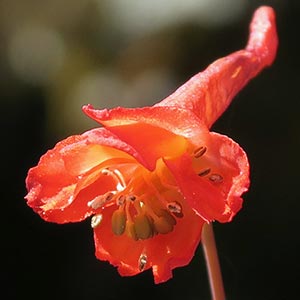Delphinium nudicaule
Delphinium gracilentum
canyon delphinium, canyon larkspur, orange larkspur, red larkspur, red or orange larkspur, scarlet larkspur
Greene's larkspur, meadow larkspur, pine forest larkspur, slender or Greene's larkspur
(15-)20-50(-125) cm;
base reddish, glabrous.
(15-)30-50(-80) cm;
base reddish, nearly glabrous.
blade round to pentagonal, 2-6 × 3-10 cm; ultimate lobes 3-12, width 5-40 mm (basal), 2-20 mm (cauline).
blade round to pentagonal, 1.5-4 × 3-7 cm, nearly glabrous; ultimate lobes 3-7, distinctly wedge-shaped, usually 5 or fewer extending 3/5 distance to petiole, width 5-20 mm (basal), 1-15 mm (cauline), widest in distal 1/2.
5-20(-69)-flowered;
pedicel (1.5-)2-6(-8) cm, glabrous to glandular-pubescent;
bracteoles 14-20(-30) mm from flowers, green to red, linear, 2-4(-9) mm, glabrous to puberulent.
5-20(-38)-flowered;
pedicel spreading from rachis at nearly 90°, 1-3(-4) cm, glabrous or glandular-pubescent;
bracteoles (7-)11-19 mm from flowers, blue or green, linear, 2-5 mm, puberulent to glabrous.
sepals scarlet to reddish orange, rarely dull yellow, glabrous, lateral sepals forward-pointing to form pseudotube, (6-)8-13(-16) × 3-6 mm, spurs straight, slightly ascending, (12-)18-27(-34) mm;
lower petal blades elevated, exposing stamens, 2-3 mm, clefts 0.5-1 mm;
hairs sparse, evenly dispersed, yellow.
sepals dark bluish purple to pink or white, usually retaining color upon drying, glabrous, lateral sepals reflexed, 6-10(-13) × 3-6 mm, spurs often curved upward, within 30° above or below horizontal, 8-12(-14) mm;
lower petal blades elevated, exposing stamens, 3-5 mm, clefts 1-3 mm;
hairs almost exclusively near base of cleft, centered or mostly on inner lobes, usually yellow.
13-26 mm, 3.5-4.5 times longer than wide, glabrous.
8-16 mm, 3-3.5 times longer than wide, glabrous to glandular-puberulent.
unwinged or sometimes slightly wing-margined;
seed coat cells with surfaces smooth.
unwinged;
seed coats ± pitted, cell surfaces roughened.
= 16.
Delphinium nudicaule
Delphinium gracilentum
Delphinium nudicaule hybridizes with most other taxa of Delphinium that it encounters. Apparent hybrids involving D. nudicaule, and seen by the author (either afield or as specimens), include D. andersonii, D. antoninum, D. decorum, D. luteum, D. nuttallianum, D. patens, and D. trolliifolium. In addition, garden-grown plants have been hybridized with D. cardinale, D. elatum, D. menziesii, D. parishii, D. penardii, D. tatsienense Franchet, D. triste Fischer ex de Candolle, and D. uliginosum; D. nudicaule does not naturally occur with these species. Delphinium nudicaule is one of the earliest larkspurs to flower in any given locality. Douglas's type collection of D. nudicaule represents plants (synonyms D. sarcophyllum Hooker & Arnott and D. peltatum Hooker, an invalid name) grown under very moist conditions, probably quite near the ocean. The type specimen of D. armeniacum A. Heller represents plants grown under unusually dry conditions.
The Mendocino Indians consider Delphinium nudicaule a narcotic (D. E. Moerman 1986).
(Discussion copyrighted by Flora of North America; reprinted with permission.)
Delphinium gracilentum hybridizes with D. patens subsp. patens in the northern Sierra Nevada foothills and is very similar to that species, making hybrids difficult to discern. While D. gracilentum and D. patens are easily distinguished in most of their ranges, morphologic distinctions between the two taxa are blurred in the northern Sierra Nevada foothills region, particularly in Butte County, California. Coniferous woods are preferred by D. gracilentum; D. patens subspp. patens and hepaticoideum are more often found in broadleaf woods. The former species has more widely spreading pedicels than the latter, and D. gracilentum usually has wider leaf lobes than D. patens subsp. patens. In the southern Sierra Nevada, D. gracilentum may come in contact with D. patens subsp. montanum. Though hybrids are not common, some gene flow has apparently occurred.
Sepal color phases are not stable and considerable variation occurs within populations. The type specimen of Delphinium gracilentum represents the northern, lower elevation, nonglandular, dark-flowered phase. The type specimen of D. gracilentum forma versicolor Ewan differs only by its pink or white flowers. A limited range of intermediate colors occurs, and populations may be made up of plants of a single color or several different colors. The type specimen of D. greenei Eastwood represents the southern, higher elevation, glandular (at least on pedicels) expression. The type specimen includes representatives of dark- and light-flowered individuals of this phase. The type specimen of D. gracilentum forma versicolor (not seen by the author) is the "albino" phase referred to by Greene in his description of D. gracilentum. Several of the paratypes cited by Ewan have been seen, as have a number of individuals in natural populations.
Delphinium gracilentum has been confused with D. patens or D. nuttallianum. Delphinium gracilentum may be distinguished from D. nuttallianum by its wider leaf lobes, smaller fruits, and more elongate inflorescences, and from D. patens by its wider leaf lobes, more open inflorescences, and usually shorter fruits.
(Discussion copyrighted by Flora of North America; reprinted with permission.)


